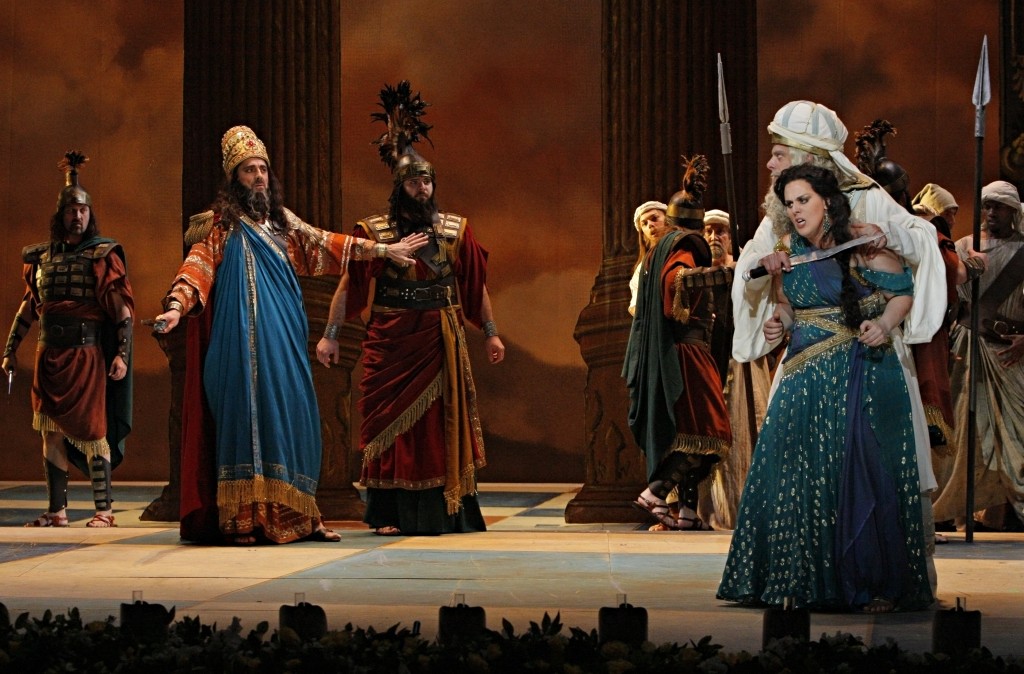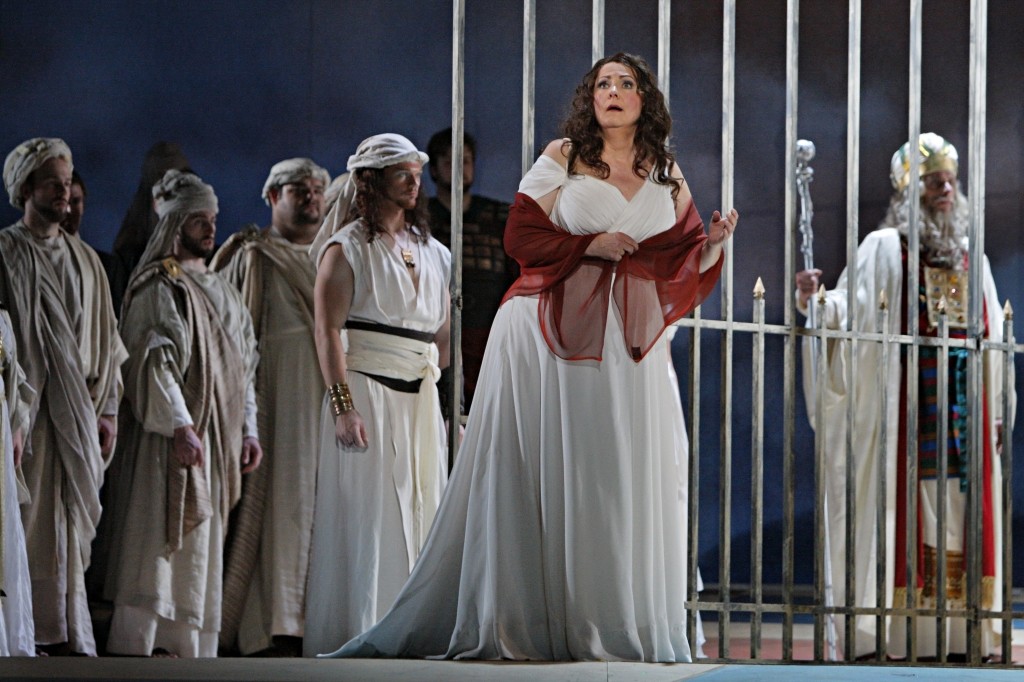
Minnesota Opera’s 50th season opens triumphantly with Verdi’s “Nabucco”
Minnesota Opera, a Knight Arts grantee, celebrated the launch of its 50th-anniversary season with a spectacular iteration of Giuseppe Verdi’s seldom-staged third opera, “Nabucco,” comprised of four tableaux loosely rooted in the biblical tale of the Babylonian conquest of Judah – the sacking of Jerusalem and destruction of the Hebrew nation’s First Temple.
Jason Howard as Nabucco, King of Babylon, John Relyea as Zaccaria, High Priest of the Hebrews, Victoria Vargas as Fenena, younger daugher of Nabucco and Company in the Minnesota Opera production of Nabucco. Photo by Michal Daniel
Verdi’s “Nabucco” (short for Nabucodonosor, or Nebuchadnezzar II, the conquering Assyrian king of biblical legend) premiered in 1842 in Milan’s famous Teatro alla Scala. Mid-19th-century Italy was a fragmented nation, largely under foreign rule and seething with political and civil unrest. In “Va, pensiero,” at the opera’s climax, the chorus of Hebrew slaves sing an elegy for the “banks of Jordan and Zion’s toppled towers… so beautiful and lost.” The song struck a chord with its original audiences immediately, becoming an anthem of the Risorgimento, a grassroots nationalist reunification movement. In the program notes, artistic director Dale Johnson says Verdi gave voice to “the Italian soul … articulated through the plight of the Jewish nation under the yoke” of invading armies and religious persecution.
Notice the “play-within-a-play” framing – the box seats at stage right, filled with 19th-century well-to-do Austrian military and Italian gentry. Pictured: Richard Ollarsaba as High Priest of Baal and Company in the Minnesota Opera production of Nabucco. Photo by Michal Daniel
The connections between the biblical story and the historical narrative of 1840s Italy are underscored subtly throughout Minnesota Opera’s production of “Nabucco,” thanks to director and scenic designer Thaddeus Strassberger’s ingenious play-within-a-play staging. He literally frames the opera with its history: Austrian soldiers and well-heeled, beautifully costumed 19th-century Milanese respectively march and dance their way to box seats set up on stage right; we occasionally see period-dressed stage hands working behind the scenes. The opera itself plays against a backdrop of marvelously hand-painted sets and bas-relief sculptures, modeled closely on the original designs for the opera’s debut at La Scala, which further situates Verdi’s classic work in the cultural and political context from which it springs.
Between the intertwined historical narratives and the pitch-perfect 19th-century ambiance and Old World stagecraft, Strassberger teases from Verdi’s occasionally ponderous work a bracing shift in perspective: the storytelling ingenuity effectively recasts this lesser-known Verdi opera anew, allowing contemporary audiences fresh avenues of insight. There’s enough nuance in the peripherals alone to chew on for weeks after the curtain closes.
And we haven’t even talked about the music yet: Minnesota Opera’s “Nabucco” has all the bombast and theatrical extravagance you’d expect from epic Italian opera. The sheer number of people on stage (a chorus of Hebrew slaves and Assyrian fighters 57 voices strong, plus more than 20 extras and 10 dancers), combined with consistently tight, muscular playing from the orchestra below, led by the company’s newly named musical director, Michael Christie, lend the vivid proceedings on stage gravitas and historical sweep.
The principals assembled here – in particular, baritone Jason Howard as Nabucco and mezzo Victoria Vargas as his younger daughter, Fenena – are all formidably talented vocalists. But soprano Brenda Harris steals the show. As Nabucco’s vindictive elder daughter, Abigaille, Harris creates a deliciously malevolent villain, but one whose magnificent furies are tempered by unexpected and genuine moments of pathos. The role requires incredible vocal range and stamina of the singer; musically, it’s a fiendishly difficult part, but Harris makes it look easy – fluidly traversing from high to low registers, tackling each phrase with emotional nuance and passion. The night I saw the show, she brought down the house.
With a Pulitzer-winning commission and a string of critically acclaimed productions to its credit, the company’s 2011-12 season will be a hard act to follow. But if Minnesota Opera’s opulent, innovative production of “Nabucco” is any gauge, we may well have even better things in store from the company this year.
Given the financial turmoil and labor disputes troubling the Twin Cities’ other august classical music institutions, Minnesota Opera’s 50 years (not to mention 10 years running of finishing the year with balanced budgets and ledgers in the black) feel like cause for celebration indeed.
John Robert Lindsey as Ismaele, nephew of the King of Jerusalem, Brenda Harris as Abigaille, presumed daugher of Nabucco, John Relyea as Zaccaria, High Priest of the Hebrews and Company in the Minnesota Opera production of Nabucco. Photo by Michal Daniel
“Nabucco” by Giuseppe Verdi was on stage at the Ordway Center of Performing Arts in St. Paul from September 22-30. For information on the company’s next production, “Anna Bolena” by Gaetano Donizetti, visit www.mnopera.org.
Recent Content
-
Artsarticle ·
-
Artsarticle ·
-
Artsarticle ·


